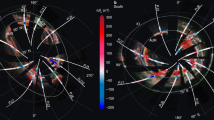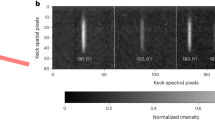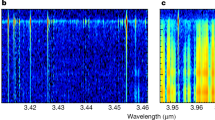Abstract
Planetary aurorae are formed by energetic charged particles streaming along the planet’s magnetic field lines into the upper atmosphere from the surrounding space environment. Earth’s main auroral oval is formed through interactions with the solar wind1, whereas that at Jupiter is formed through interactions with plasma from the moon Io inside its magnetic field (although other processes form aurorae at both planets2,3). At Saturn, only the main auroral oval has previously been observed and there remains much debate over its origin. Here we report the discovery of a secondary oval at Saturn that is ∼25 per cent as bright as the main oval, and we show this to be caused by interaction with the middle magnetosphere around the planet. This is a weak equivalent of Jupiter’s main oval, its relative dimness being due to the lack of as large a source of ions as Jupiter’s volcanic moon Io. This result suggests that differences seen in the auroral emissions from Saturn and Jupiter are due to scaling differences in the conditions at each of these two planets, whereas the underlying formation processes are the same.
This is a preview of subscription content, access via your institution
Access options
Subscribe to this journal
Receive 51 print issues and online access
$199.00 per year
only $3.90 per issue
Buy this article
- Purchase on Springer Link
- Instant access to full article PDF
Prices may be subject to local taxes which are calculated during checkout



Similar content being viewed by others
References
Dungey, J. W. Interplanetary magnetic field and the auroral zones. Phys. Rev. Lett. 6, 47–48 (1961)
Hill, T. W. The Jovian auroral oval. J. Geophys. Res. 106, 8101–8108 (2001)
Cowley, S. W. H. & Bunce, E. J. Origin of the main auroral oval in Jupiter’s coupled magnetosphere–ionosphere system. Planet. Space Sci. 49, 1067–1088 (2001)
Cowley, S. W. H., Bunce, E. J. & O’Rourke, J. M. A simple quantitative model of plasma flows and currents in Saturn’s polar ionosphere. J. Geophys. Res. 109, A05212 (2004)
Sittler, E. C., Blanc, M. F. & Richardson, J. D. Proposed model for Saturn’s auroral response to the solar wind: Centrifugal instability model. J. Geophys. Res. 111, A06208 (2006)
Trauger, J. T. et al. Saturn’s hydrogen aurora: Wide field and planetary camera 2 imaging from the Hubble Space Telescope. J. Geophys. Res. 103, 20237–20244 (1998)
Gérard, J.-C. et al. Characteristics of Saturn’s FUV aurora observed with the Space Telescope Imaging Spectrograph. J. Geophys. Res. 109, A09207 (2004)
Clarke, J. T. et al. Morphological differences between Saturn’s ultraviolet aurorae and those of Earth and Jupiter. Nature 433, 717–719 (2005)
Crary, F. J. et al. Solar wind dynamic pressure and electric field as the main factors controlling Saturn’s aurorae. Nature 433, 720–722 (2005)
Stallard, T. et al. The H3+ latitudinal profile of Saturn. Astrophys. J. 521, L149–L152 (1999)
Melin, H., Miller, S., Stallard, T., Trafton, L. M. & Geballe, T. R. Variability in the H3+ emission of Saturn: Consequences for ionisation rates and temperature. Icarus 186, 234–241 (2007)
Stallard, T., Miller, S., Trafton, L. M., Geballe, T. R. & Joseph, R. D. Ion winds in Saturn’s southern auroral/polar region. Icarus 167, 204–211 (2004)
Stallard, T. et al. Saturn’s auroral/polar H3+ infrared emission II: A comparison with plasma flow models. Icarus 191, 678–690 (2007)
Stallard, T. et al. Saturn’s auroral/polar H3+ infrared emission I: General morphology and ion velocity structure. Icarus 189, 1–13 (2007)
Badman, S. V., Cowley, S. W. H., Gérard, J.-C. & Grodent, D. A statistical analysis of the location and width of Saturn’s southern auroras. Ann. Geophys. 24, 3533–3545 (2006)
Stallard, T., Miller, S., Millward, G. & Joseph, R. D. On the dynamics of the Jovian ionosphere and thermosphere II: The measurement of H3+ vibrational temperature, column density, and total emission. Icarus 156, 498–514 (2002)
Grodent, D. et al. Jupiter’s polar auroral emissions. J. Geophys. Res. 108, 1366–1374 (2003)
Saur, J. et al. Anti-planetward auroral electron beams at Saturn. Nature 439, 699–702 (2006)
Grodent, D., Gérard, J.-C., Cowley, S. W. H., Bunce, E. J. & Clarke, J. T. Variable morphology of Saturn’s southern ultraviolet aurora. J. Geophys. Res. 110, A07215 (2005)
Cowley, S. W. H. & Bunce, E. J. Corotation-driven magnetosphere–ionosphere coupling currents in Saturn’s magnetosphere and their relation to the auroras. Ann. Geophys. 21, 1691–1707 (2003)
Stallard, T., Miller, S., Cowley, S. W. H. & Bunce, E. J. Jupiter’s polar ionospheric flows: Measured intensity and velocity variations poleward of the main auroral oval. Geophys. Res. Lett. 30, 1221–1224 (2003)
Stallard, T., Miller, S., Millward, G. & Joseph, R. D. On the dynamics of the Jovian ionosphere and thermosphere I: The measurement of ion winds. Icarus 154, 475–491 (2001)
Greene, T. P., Tokunaga, A. T., Toomey, D. W. & Carr, J. S. CSHELL: A high spectral resolution 1–5 micron cryogenic echelle spectrograph for the IRTF. Proc. SPIE 1946, 313–324 (1993)
Acknowledgements
We thank the NASA Infrared Telescope Facility (IRTF) telescope operators for their continued support and expert advice in making these observations possible. The authors are part of the Europlanet European planetary science network, supported by the European Union’s Framework 6 programme. This work was supported by the UK Science and Technology Facilities Council, with postdoctoral fellowships for T.S., N.A. and E.J.B., and a senior fellowship for M.D. T.S. is now funded by an RCUK Fellowship. H.M. was supported by a postgraduate studentship from the UK Engineering and Physical Sciences Research Council. S.W.H.C. was supported by a Royal Society Leverhulme Trust Senior Research Fellowship. T.S., H.M. and M.L. are visiting astronomers at the IRTF, which is operated by the University of Hawaii under Cooperative Agreement no. NCC 5-538 with the NASA Science Mission Directorate, Planetary Astronomy Program.
Author Contributions T.S. designed the study, collected and analysed data and wrote the paper. S.M. collected and aided data analysis. H.M. and M.L. aided data analysis. S.W.H.C., E.J.B, N.A. and M.D. provided the magnetospheric context. All authors discussed the results and commented on the manuscript.
Author information
Authors and Affiliations
Corresponding author
Supplementary information
Supplementary information
The file contains Supplementary Figure 1 with Legend and Supplementary Discussion. This discussion shows the effect of changing the location of the modelled oval away from the statistically averaged UV oval used in the paper. Moving the oval towards the planetary limb weakens the secondary auroral oval, but does not change its location with respect to the break down in corotation. (PDF 91 kb)
Rights and permissions
About this article
Cite this article
Stallard, T., Miller, S., Melin, H. et al. Jovian-like aurorae on Saturn. Nature 453, 1083–1085 (2008). https://doi.org/10.1038/nature07077
Received:
Accepted:
Issue Date:
DOI: https://doi.org/10.1038/nature07077
This article is cited by
-
Auroral Processes at the Giant Planets: Energy Deposition, Emission Mechanisms, Morphology and Spectra
Space Science Reviews (2015)
-
Solar Wind and Internally Driven Dynamics: Influences on Magnetodiscs and Auroral Responses
Space Science Reviews (2015)
-
Complex structure within Saturn’s infrared aurora
Nature (2008)
Comments
By submitting a comment you agree to abide by our Terms and Community Guidelines. If you find something abusive or that does not comply with our terms or guidelines please flag it as inappropriate.



